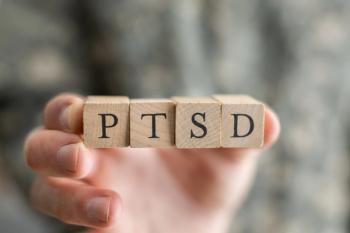
- Vol 37, Issue 4
- Volume 37
- Issue 4
The Other #MeToo: Male Sexual Abuse Survivors
Key Takeaways
- Male sexual assault is underreported due to stigma, shame, and societal misconceptions about masculinity.
- Men often struggle with psychological symptoms like anger, sexual dysfunction, and self-blame, impacting relationships and self-esteem.
Clinicians work with more male sexual abuse survivors than they may think.
ANXIETY AND STRESS DISORDERS
April is
The public and some health care providers may hear the words men and sexual assault and automatically assume that men are the perpetrators. Somehow seeing men as the targets of sexual violence is difficult to comprehend. The truth is it is hard for most men to see themselves as victims or as someone who has been abused. That is one of the reasons why we encourage the men with whom we work to see themselves as survivors-a small but important change in language that connotes resilience and empowerment.
Trauma in men
Case Vignette
“Bill” is 45 years old. Married for 20 years, he and his wife have two children. Bill reports that he and his wife are no longer intimate emotionally, and he finds it difficult to talk with his wife, be affectionate, and often finds himself zoning out when his wife is talking to him. Bill works as a retail supervisor; he noted difficulty holding onto jobs for longer than a year, often due to angry outbursts and irritability that are difficult to control.
When directly asked if he has experienced any traumatic events in his life, he reported none. In answering additional intake questions, he noted that some “funny business” had occurred when he was 14 years old when his next-door neighbor touched him inappropriately.
How and why is it so hard for men to recognize and acknowledge the occurrence of this type of trauma and subsequent mental health problems, and how can we help them?
While traumatic events are quite common in the general population, most people do not have long-standing negative mental health consequences as a result. However, with some traumatic events there is higher incidence mental health difficulties. Sexual trauma packs a huge wallop compared with other traumatic experiences. The probability of having negative consequences is much higher with sexual abuse compared with most other traumatic events. Individuals who experience sexual abuse or assault are at risk for a wide range of medical, psychological, behavioral, and sexual disorders.
Men who have experienced sexual abuse and assault may have very prominent psychological symptoms that are not easily captured in any one psychiatric diagnosis. For example, males who have been sexually assaulted often have buckets of seething anger. This never leaves them but especially comes out when they are feeling threatened or betrayed. Another example is difficulties with sexual functioning such as low sex drive or erectile problems, which not only affects self-esteem and sense of manhood but also interferes with intimate relationships. They may also feel unable to give or feel love or happiness, effects that reverberate into every aspect of their life.
Men who have been sexually assaulted may have concerns about their masculinity as well as their sexual orientation; they struggle intensely with shame and self-blame.3 They are less likely to report sexual abuse, to identify experiences they have had as abusive, and to seek support or formal treatment for these experiences.4-6
Boys and men are socialized to see themselves as strong, tough, and self-sufficient. Acknowledging feelings and disclosing vulnerabilities are in some ways antithetical to traditional masculine roles. Men also frequently wear thick coats of shame, having internalized the blame. When they do disclose, they are frequently met with disbelief, such as “That’s impossible. A man can’t be raped.” Or they are met with invalidation and victim-blaming such as, “How could you let that happen?”
Barriers to treatment
All kinds of male rape myths are responsible for delayed treatment seeking and perpetuating stigma (
Because many patients may not be completely forthcoming about their histories, patients should always be asked about exposure to traumatic events, including sexual abuse. It is also important to provide validation of the occurrence of the experience and to help the patient understand the connection between the trauma and consequent difficulties.
Supporting male survivors
It is important to offer male survivors a safe place where they are believed and accepted. Many male survivors with whom we have worked over the years tell us that having someone who listened and did not question the validity of their story was paramount to their healing.
The therapeutic alliance is predictive of, or associated with, a reduction in various symptoms.9 However, it is not enough to have a kind, caring, non-judgmental therapist. A mental health clinician who works with male sexual abuse survivors should have the knowledge and skills to understand and help patients who have been abused. For example, some well-intentioned providers may discourage their male patients from talking about their traumatic experiences. They may inaccurately think that talking about such experiences will open Pandora’s box or they themselves may be uncomfortable hearing details of the abuse.
While it may be upsetting for the patient, working through the trauma narrative in a process-oriented or more formalized exposure-based manner is tremendously helpful. Many patients tell us that the more they talk about it, the less impact the abuse has on them. And those discussions of the traumatic event, including details no matter how graphic, can allow survivors to understand and process what happened.
We have also worked with male survivors who have told us that their therapist seemed inappropriately voyeuristic, wanting explicit details of the abuses and appeared excited and eager to hear more, which felt like being abused all over again. Others have told us stories of therapists grimacing in disgust or pain or communicating an inability to hear the patients’ stories, all of which perpetuates shame and silence.
After disclosing the pain of their traumatic experiences, some survivors were met with insensitive, inaccurate, victim-blaming, and dismissive reactions. One patient told us that when he told his therapist that he needed to talk about the sexual abuse he had experienced, the response was, “I hope you are not one of those homosexuals who are going to waste my time telling me about imagined sexual abuse.” By reinforcing the patient’s belief that he was a severely flawed human being, the comment kept him from seeking help for many years.
Treatments for adults
There are numerous guidelines that provide recommendations on psychological and pharmacological treatments for posttraumatic stress disorder in adults (
The guidelines do not make recommendations for first-line treatment-psychotherapy first or instead of medications-because of insufficient evidence. The assignment of a strong recommendation is based primarily on a harm-to-benefit analysis, with more benefits seen as a result of psychological treatments for these patients.
In a meta-analysis of PTSD treatment for adults, trauma-focused psychotherapies were compared with selective serotonin reuptake inhibitors or serotonin and norepinephrine reuptake inhibitors.13 Only four studies met inclusion criteria; of those, two were deemed at high risk of bias. The unbiased studies showed no difference in PTSD symptom reduction but had wide confidence intervals. The authors concluded that there is insufficient evidence to determine whether medications or trauma-focused psychotherapies are more effective for PTSD symptom reduction.
Guidelines are intended to simplify treatment decision-making and as such, they are not rigid. While we celebrate several effective psychotherapies and pharmacotherapies for PTSD, it is possible that male survivors may refuse to participate or drop out before completing therapy. Moreover, they may engage in these therapies but not experience their full benefit and are thus in need of ongoing care. For example, in one study of interpersonal assault survivors who received an evidence-based psychotherapy for PTSD, women evidenced more rapid gains on global guilt, guilt cognitions, anger/irritability, and dissociation as compared with men.14
Shared decision-making that takes into account the values and preferences of patients is essential as is the consideration of benefits and harms of any intervention. Educating trauma survivors also allows shared decision making. Thus, clinicians should be ready to offer information about evidence-based options. They also should teach coping skills while being sensitive to cultural and socio-demographic differences.
Case Vignette (cont’d)
What are Bill’s treatment options? During Bill’s appointment, the clinicians should elicit his treatment preferences and ask about his current functioning. Following a three-phase model, ensure Bill is safe, stable, and utilizing healthy coping skills before delving into trauma processing. Begin by providing psychoeducation about available treatments specific for trauma processing (eg, prolonged exposure and cognitive processing therapy), as well as treatments that are trauma-informed though not trauma-focused (eg, cognitive behavioral therapy, dialectical behavior therapy) that might help Bill with his impulsivity and anger. Since anger may be a symptom of depression, let Bill know that an SSRI (eg, fluoxetine, paroxetine, sertraline, and venlafaxine) would be a useful adjunct to the psychotherapy.
Conclusions
The characteristics of the abuse as well as male survivors’ responses may be different, which can have an impact on assessment and treatment. For example, the assault may involve a single occurrence of penetration by several perpetrators (ie, a gang rape that occurs while a man is a young adult serving in the military or in a fraternity) or it may involved skilled grooming of a boy by an older and deceptively admirable figure such as a priest, coach, or teacher.
Of course, some men who have experienced sexual abuse or assault may not have significant mental health difficulties or may recover on their own without professional intervention. Similarly, some male survivors may have difficulties that wax and wane across their lifespan, becoming particularly strong with certain triggers (eg, smells) or during particular times of the year (eg, anniversary of the abuse). Others, especially those with severe and prolonged abuse histories, may experience more profound or longer- term problems.
Some patients may prefer a support group rather than one-on-one counseling.15 Peer-based support lets survivors know that they are not alone and removes the element of a power hierarchy or judgment. Regardless of their treatment choice, it is our hope that survivors can work through their traumatic experience and live a healthy and meaningful life.
Dr Cook is Associate Professor, Department of Psychiatry, Yale University School of Medicine, New Haven, CT. Dr Ellis is Assistant Director, Nova Southeastern University Trauma Resolution and Integration Program, Fort Lauderdale, FL. The authors report no conflicts of interest concerning the subject matter of this article.
References
1. Dube SR, Anda RF, Whitfield CL, et al. Long-term consequences of childhood sexual abuse by gender of victim. Am J Prev Med. 2005;28:430-438.
2. Smith SG, Chen J, Basile KC, et al. The National Intimate Partner and Sexual Violence Survey (NISVS): 2010-2012 State Report. Atlanta, GA: National Center for Injury Prevention and Control, Centers for Disease Control and Prevention; 2008.
3. O’Brien C, Keith J, Shoemaker L. Don’t tell: military culture and male rape. Psychol Serv. 2015;12:357-365.
4. Sorsoli L, Grossman FK, Kia-Keating M. “I keep that hush-hush”: male survivors of sexual abuse and the challenges of disclosure. J Couns Psychol. 2008;55:333-345.
5. Artime TM, McCallum EB, Peterson ZD. Men’s acknowledgment of their sexual victimization experiences. Psychol Men Masc. 2014;15:313-323.
6. Monk-Turner E, Light D. Male sexual assault and rape: who seeks counseling? Sex Abuse. 2010;22:255-265.
7. Kantor V, Knefel M, Lueger-Schuster B. Perceived barriers and facilitators of mental health service utilization in adult trauma survivors: a systematic review. Clin Psychol Rev. 2017;52:52-68.
8. Easton SD. Disclosure of child sexual abuse among adult male survivors. Clin Soc Work J. 2013;41:344-355.
9. Ellis AE, Simiola V, Brown L, et al. The role of evidence-based therapy relationships on treatment outcome for adults with trauma: a systematic review. J Trauma Dissoc. 2018;19:185-213.
10. American Psychiatric Association. Practice Guideline for the Treatment of Patients With Acute Stress Disorder and Posttraumatic Stress Disorder; 2004.
11. Department of Veterans Affairs & Department of Defense. VA/DoD Clinical Practice Guideline for the management of posttraumatic stress and acute stress disorder (version 3.0). Washington, DC: Authors; 2017.
12. Guideline Development Panel for the Treatment of PTSD in Adults, American Psychological Association. Summary of the Clinical Practice Guideline for the Treatment of Posttraumatic Stress Disorder (PTSD) in Adults. Am Psychol. 2019;74:596-607.
13. Sonis J, Cook JM. Medication versus trauma-focused psychotherapy for adults with posttraumatic stress disorder: a systematic review and meta-analysis. Psychiatry Res. 2019;282:112637.
14. Galovski TE, Blain LM, Chappuis C, Fletcher T. Sex differences in recovery from PTSD in male and female interpersonal assault survivors. Behav Res Ther. 2013;51:247-255.
15. Cook JM, Anderson C, Simiola V, Ellis AE. Top ten questions male sexual abuse survivors want to know from health care research. J Aggress Maltreat Trauma. 2018;27:867-882.
Articles in this issue
over 5 years ago
The Name “Schizophrenia” Is Heard Worldwideover 5 years ago
Big Brother FDA Is Watching, Helpingover 5 years ago
Drug Receptor Profiles Matterover 5 years ago
Let’s Talk About Resilienceover 5 years ago
25 Years After the Oklahoma City Bombingover 5 years ago
Resilience, Not Panic, in a Time of Pandemicover 5 years ago
What Is the Deal With Esketamine?Newsletter
Receive trusted psychiatric news, expert analysis, and clinical insights — subscribe today to support your practice and your patients.














